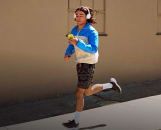
Djordje Krstic/iStock/Getty Images Plus via Getty Images
Here’s Why Winter Is the Perfect Time to Focus on Strength—Especially For Runners
You officially have an excuse not to run during dark, cold winter mornings.
By Lauren Mazzo•
Why Runners Should Lift Heavier In the Winter
How to Adapt Your Running Routine While Lifting Heavier
4 Winter Strength Training Tips
Do you struggle to get outside and log runs during the cold winter months? We have just the excuse you need to run less this winter and sub in other types of training instead—namely, resistance training. Whether you think of it as bulking, your “off-season,” or a sort of hibernation, the fact is that most runners can benefit from focusing the next few months on building muscle.
“Winter can be a great time to work on overall strength training because races and events typically take place during the warmer months,” says Peloton instructor Matt Wilpers. “But even if you don’t compete in events or races, it's healthy to have seasonality to your training.”
And though everyone’s needs are different depending on their fitness goals, level of experience, and location, lifting more or heavier during the winter could be a smart move for runners for many different reasons. We’ll get into why below and how to tweak your training this winter to prioritize strength—without abandoning running completely.
Why Runners Should Lift Heavier In the Winter
There are a lot of potential perks to focusing on strength training in the winter, from the obvious (less frostnip on your toes, no more frozen eyelashes) to the not-so-obvious (improved performance and better recovery). Let’s get into it.
It Adds Variation Into Your Training
Theoretically, you could follow the same workout routine year-round, but you’d likely stop seeing results. Variation or periodization—the process of systematically altering one or more variable(s) in your workout program over time—is a core principle of resistance training. It ensures your workouts remain challenging and effective by preventing overtraining and plateaus, according to the American College of Sports Medicine (ACSM). Taking a few months in the winter as an opportunity to focus on strength work comes with all the benefits below and also ensures you’re varying your training.
It’s a Great Time to Build a Strength Base
During an athlete’s “off-season,” the National Strength and Conditioning Association (NSCA) recommends undergoing a general preparation phase to develop a base level of conditioning. During this period, they suggest you keep the resistance training low- to moderate-intensity and the overall volume (think: number of sets and reps) high. There’s a good chance the winter is sort of like your off-season (whether because you’re not racing or you just don’t like doing long runs on the treadmill), making it the perfect time to dial in your conditioning.
And, in case you didn’t know, it takes a long time to build muscle and strength. According to the NSCA, the results you see during the first four to eight weeks of resistance training are mainly neural, not muscular. (Basically, your nervous system gets better at coordination and recruiting muscle fibers, which translates to being able to lift heavier weights.) Once you hit eight weeks, more muscular changes, such as an increase in muscle size, start taking place. If you hope to make real strength improvements, you’ll need to keep lifting for several months.
Sticking with consistent strength training for that long can be tricky during summer if you’re working around long outdoor runs or other activities for which you want fresh legs. “In the winter, you also have the opportunity to lift heavier because the residual fatigue will not interfere with training for your races or events,” Matt says. “For example, because you're not doing a hard run the day of or after an intense strength training session.”
It Primes You to Perform Come Race Season
“When training for races and events, it typically makes sense to start with improving your overall general fitness and then working towards the specific demands of the race you’re training for as the event gets closer,” Matt says. If you tend to race (or just run more) during the spring, summer, or fall, you’ll likely be working with a reduced volume and intensity of your run training during the winter. “So, you can replace it with an increase in volume and intensity of strength training,” Matt says. “The benefits from improving your strength can then be carried forward into your training season by continuing to do strength maintenance work.” For example, research has found that high-load (i.e., heavy), plyometric, or mixed-method strength training can improve running economy (aka efficiency), time trial performance, and maximal sprints.
It Comes with a Lot of Health Benefits
No matter what time of year you do it, “lifting heavier has many health benefits, including stronger muscles and bones,” Matt says. “These are benefits that will pay dividends throughout the training year ahead,”—not to mention the whole rest of your life. For example, Strength training may help reduce your injury risk, improve bone health and mental health, and help preserve muscle tissue, which naturally declines as you age.
It Allows For Better Recovery
Humans may not hibernate like bears, but we do settle in for the winter in our own way. A 2023 study published in Frontiers in Neuroscience found that people tend to get up to one more hour of sleep and spend more time in REM during the winter compared to the summer. Sleep is vital for everyone’s health, but it’s especially crucial for athletes or anyone who works out since insufficient sleep can affect performance, increase injury risks, and disrupt physiological functions. When you engage in resistance training, you’re actually breaking down your muscle tissue so it can adapt and grow back stronger. Sleep is when the body repairs tissues and builds muscle, making it key for muscle recovery and regeneration.
It Taps Into Seasonal Wants and Needs
Focusing on indoor strength training during this time makes sense if you live somewhere that gets cold and snowy in the winter months. You might be running outside less due to adverse conditions, or you may naturally gravitate towards more indoor workouts like weightlifting or boot camps. In the summer, the opposite is likely true. “People typically like to be outside and therefore shift to more cardio-based training during the warmer months and less strength training,” Matt says. “So during the colder months, we tend to want to spend more time indoors...where we shift our training balance more towards the weights.” The most significant barrier to maintaining fitness is often finding the time and motivation to show up; following what feels good to you seasonally could make all the difference in helping you stay consistent and achieve your fitness goals.
How to Adapt Your Running Routine While Lifting Heavier
To make room for more intense strength work, “you’ll need to reduce the volume and intensity of your running or race training,” Matt says. “It's still a good idea to keep running, but work more on maintaining endurance vs speed.”
If you’re lifting three times a week, consider doing two or three easy runs per week to maintain your fitness without taking away from your muscle-building efforts. “This shift is not only good for you physically but also mentally as it helps you recharge and, as I like to say, ‘get hungry’ again for the more intense training to come in the spring and summer months,” Matt says.
One thing to note: If your legs are sore from lifting (it’s inevitable!), keep in mind that it’s not always a good idea to run. Take stock after your warm-up; if you’re still feeling really achy, you’re likely too sore to work out that day.
4 Winter Strength Training Tips
Truthfully? “Most people are somewhat clueless when it comes to lifting,” Matt says. “They don't know what to do in what order, let alone move correctly.” No shade—there’s a lot to know! The following tips can help you get started or ramp up safely.
Start Slow and Focus on Form
If you’re doing strength work to bolster your running performance, the last thing you want to do is injure yourself while you’re doing it. Start with simpler moves and lighter weights before progressing to heavy compound lifts, advanced moves, or plyometrics. “When lifting, I always recommend keeping the NASM Optimum Performance Training model in mind, which suggests you strength train in phases starting with stabilization endurance, before progressing to strength endurance, muscular development/hypertrophy, maximal strength, and then power,” Matt says. This essential entails starting with low weight, speed, and intensity, focusing on form, then getting more complex.
Be Consistent
You need to be consistent to see the payoff of your strength work. Remember: It takes several weeks actually to build strength and muscle. Research shows that a good off-season preparatory-phase training plan for runners includes two or three lower-body strength sessions per week, and that during the competitive season, one is sufficient to maintain strength. This matches up with recommendations from the ACSM, which suggests performing two to three alternating days per week for untrained individuals and decreasing one to two days per week for strength maintenance.
Commit to a Program
There’s no need to DIY. Just like outsourcing your nutrition plan to a registered dietitian or your house renovation to a seasoned contractor, it’s a good idea to let the pros do all the hard work in organizing your strength routine for you, especially if you’re unsure how to lift heavier in a safe way. If you’re not working with a coach or trainer, following a strength program like those offered by Peloton can help you train smarter and get better results, Matt says. Try any of these:
Ben’s The Stronger You (4 Weeks)
Pump Up the Volume (4 Weeks)
Keep Challenging Yourself
You likely progress your running by tackling longer and longer distances or pushing your pace with speed work or faster tempos. You should do the same with your strength work, too. According to the training principle of progressive overload, you need to gradually increase the demand of your workouts to keep seeing physiological adaptations. You can do this by increasing the number of reps, sets, or amount of weight lifted, or even decreasing rest time. If you follow a strength program, it should guide you through doing this from workout to workout or week to week. However, a handy rule of thumb for lifting is that if you finish a set and it felt easy, you should pick up a heavier weight for the next round.
Stick with this principle until you hear birds chirping and see spring flower buds, and you’ll be surprised just how strong you are when you stride into your warm-weather run training.
This content is for informational and educational purposes only and does not constitute individualized advice. It is not intended to replace professional medical evaluation, diagnosis, or treatment. Seek the advice of your physician for questions you may have regarding your health or a medical condition. If you are having a medical emergency, call your physician or 911 immediately.
Level up your inbox.
Subscribe for a weekly dose of fitness, plus the latest promos, launches, and events.
By providing your email address, you agree to receive marketing communications from Peloton.
For more about how we use your information, see our Privacy Policy.









